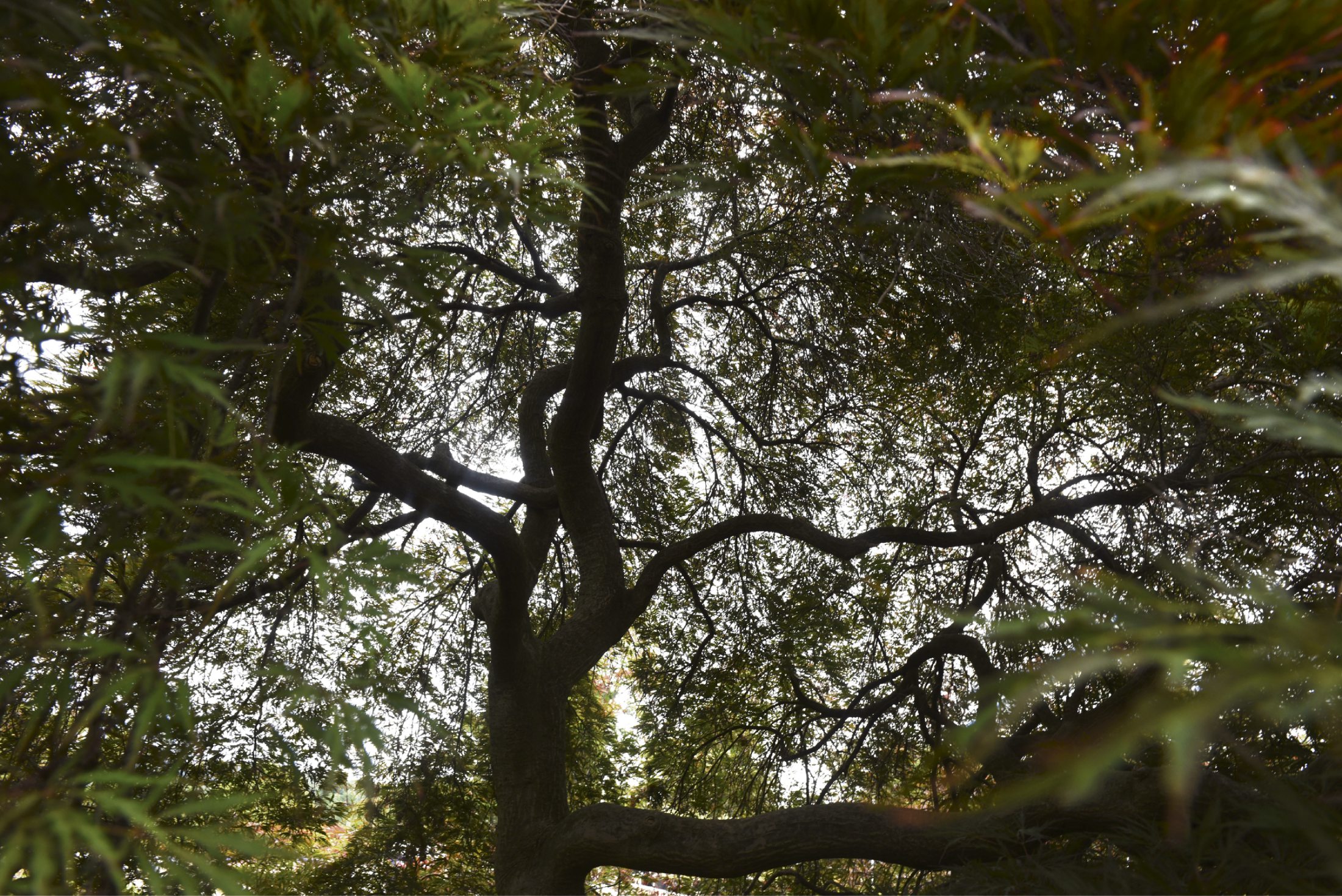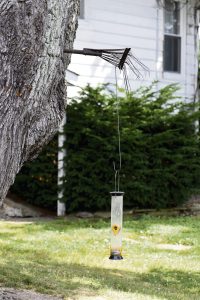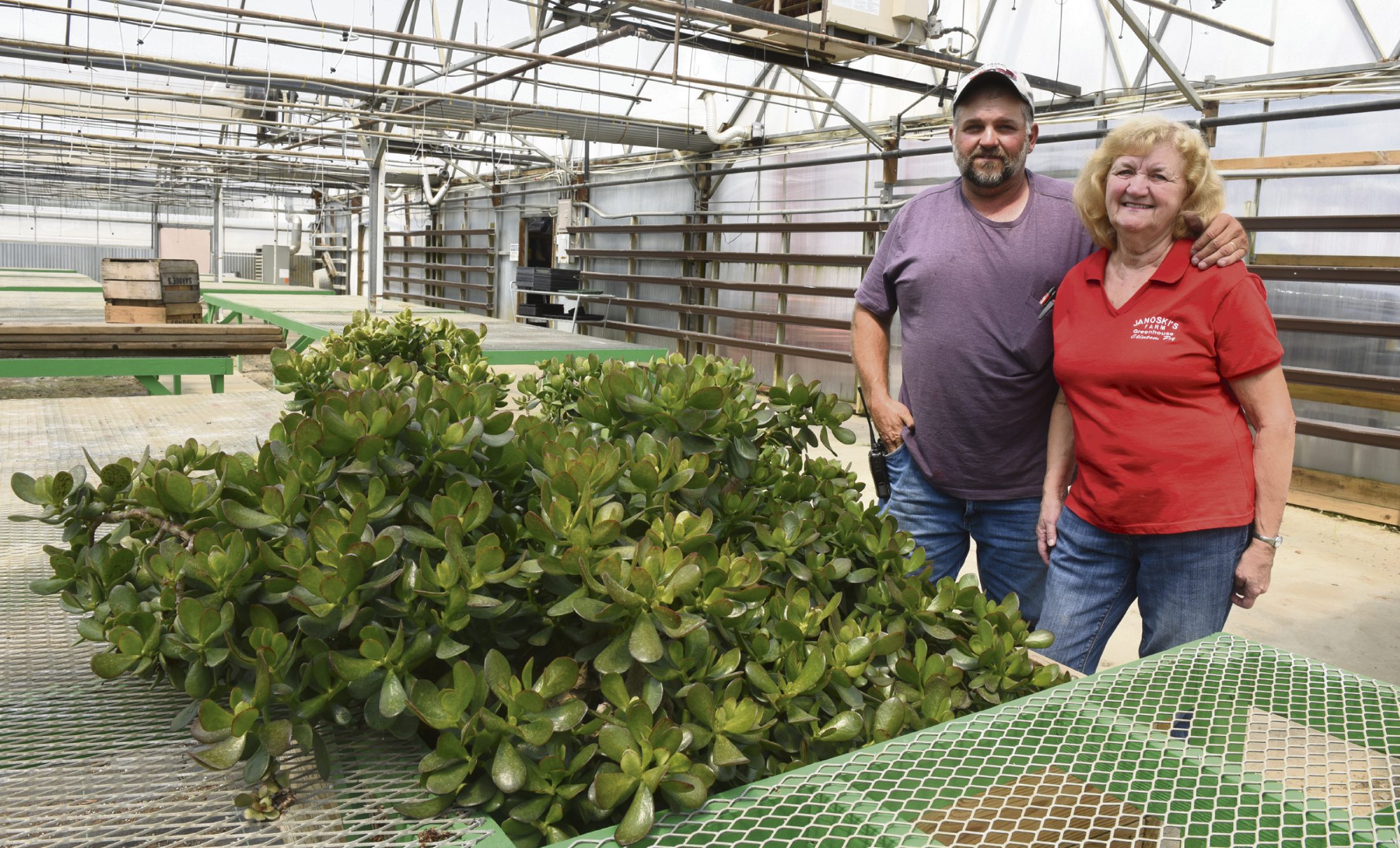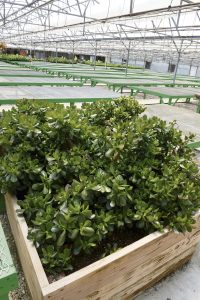Plants That Matter: 3 trees with special meaning for Western Pennsylvania families
Posted on: July 16, 2018 | Written By: Doug Oster |
Note: Doug Oster’s “Plants That Matter” series won the Gold Medal award at the 2017 Association of Garden Communicators Media Awards. They now run on Everybody Gardens as they originally appeared in the Tribune-Review. This is the first of three in the series.

This huge weeping cutleaf Japanese maple was planted in the late 1970s at Plumline Nursery in Murrysville by the late Bill Tribou. This is a look inside the canopy. The tree is one of the things that reminds the family and visitors about what a special person Bill was.
Mighty Japanese maple
It didn’t take long for Karen Crousey to fall for Bill Tribou.
After their first date, she told her mother: “I think I’ve found the guy I’m going to marry. His name is Bill and his last name starts with a T.”
They were introduced at a Bible study class. His nickname was Wild Bill, and she is a self-described goody two-shoes, but the unlikely match was meant to be. After they went out on a Friday, the couple were engaged the next Tuesday and married just six weeks later.
“I knew nothing about him, but I just loved him. I thought he was the best,” she says with a smile.

Karen Tribou holds a portrait of herself with her late husband Bill Tribou as she stands in front of a huge weeping cutleaf Japanese maple at Plumline Nursery.
In 1974, Bill opened Plumline Nursery on two acres overlooking Murrysville.
“We didn’t really know what we were doing when we started it,” Karen says, laughing. “I supported him and went for the ride.”
It began with about a dozen rhododendrons, which he would sell to friends and acquaintances. Each time he sold one, he bought two more, and that’s how the business grew.
A few years later, the self-taught nurseryman planted a weeping cutleaf Japanese maple.
“Bill loved Japanese maples his whole life,” Karen says. “That was a neat variety, so he planted it in a little spot in the nursery and put some big rocks around it.”
It is in the very center of the nursery, and at first, no one paid it much attention. A decade later, when it started to really grow, customers commented on its size and beauty.
“It sold a lot of other Japanese maples,” Karen says with a laugh. “As it grew and grew, there was interest to buy the huge specimen. One visitor even offered $7,000 for the tree, but (Bill) would not have any of it.”
Karen says he told her, “That tree is us, that tree is Plumline. People see it, people love it. It’s become a big part of our identity.”
Bill Tribou died in May 2010 after a long battle with cancer.
“Everything he planted is a connection for me to him and for the kids,” Karen says of son Micah, daughter Melody and four grandchildren. “That tree is just sturdy, solid and pretty, just like he was. He was always there, loyal and consistent, just like the tree. When I see it, I think of Bill.”
First-time visitors are always in awe of the giant, but now it has even more meaning for the family and others.
“I used to try to tell people who never met him what he was like,” Karen says. “I got to thinking, all I have to do is point to all the things that he’s planted.”
Karen, 66, and Micah, 35, run the nursery now. They don’t know the exact cultivar the tree is, although there are guesses it’s ‘Ever Red.’ But no one knows for sure except the man who planted it.
Bill Tribou was an artistic person. When building a handrail for a staircase in their home, he added something personal to the construction project. “For some reason — nobody knows why — he carved his hand’s imprint into one of the posts,” Micah says. “When you walk past, you put your hand there; it’s like you’re grabbing his hand.”
Wearing her late husband’s watch, Karen gently lays her hand over the carving on the railing. “He had cancer for so long that I think he was aware of his mortality and did leave little pieces (of himself) everywhere,” she says.
• • •

This weeping mulberry tree has been at Soergel Orchards and Greenhouses in Wexford for as long as anyone can remember. It’s something that hasn’t changed as the orchard has evolved.
Mulberry memories
At Soergel Orchards and Greenhouses in Wexford, owner Randy Soergel has lots of trees at the family homestead that have special meanings. The most important is a weeping mulberry that’s been there for as long as anyone can remember.

This maple tree was damaged in a fire in 1911 at Soergel Orchards and Greenhouses in Wexford. Warren Soergel put this rake in the tree many years ago and the maple has grown around it.
He talked to his aunt, Martha Jean Murray, 93, who remembers sitting under the tree as a child. Soergel, 60, has fond memories of the tree. As a child, he would hide inside the canopy of leaves and no one would know he was there.
“As a kid, you got these little mulberries,” he says smiling. “They were never very big, but there were hundreds of them. It’s just something that’s always been there.”
Back in the day, the tree was planted behind the ice house, which is no longer standing. There have been lots of changes over the decades at the orchard and garden center, but one thing has remained the same.
“It’s been kind of like one of those things that has been steady; you always think it’s going to blow over or fall down, but it just keeps plugging away,” Soergel says of the tree.
“I think (the tree) stands for strength; that if something can be there for so long, it’s kind of like going to a parent that you know is always going to be there,” he says. “Something steady, not changing. All my life, it’s been the mulberry tree.”
The farmhouse burned down in 1911. Even though it was only a short distance from the mulberry, the tree somehow survived, along with a couple of old maples and a towering magnolia. One maple got so hot during the fire that the center of the tree was burned and it became hollow. It was filled with cement and Randy’s father, Warren, stuck a leaf rake in the tree that is still there and is used to hang a bird feeder on.
Looking up at the magnolia while standing in the front yard with his mother, Jean, 87, the two share stories of that big tree.
“My brother would climb out the window to get out at night and climb down the magnolia tree so know one knew he was gone,” Randy says.
“His great aunt did that years before him, too,” Jean says as they laughed together.
• • •

Mike Janoski and his mother, JoAnn Janoski, stand in the greenhouse at Janoski’s Farm and Greenhouse in Clinton with a huge jade plant that was almost killed over the winter when a furnace stopped working. It’s been “part of the family” since 1976.
Jade resilience
When Mike Janoski and his wife, Patty, got a well-deserved break from running Janoski’s Farm and Greenhouse in Clinton last winter, they vacationed in Florida. While they were away, a greenhouse restoration project caused the furnace to go out on an especially cold night.
The only thing in the greenhouse that night was an immense jade plant, which has been part of the farm since 1976.

The greenhouses at Janoski’s Farm and Greenhouse are almost empty at the end of the planting season except for this huge jade plant that was almost killed over the winter when a furnace stopped working.
Mike’s brother-in-law Bill Metz, who was caring for the farm, was mortified and waited as long as possible to tell him what happened, even though Mike had called every day to check on the farm.
“The day before I was coming home, they broke the news to me because they didn’t want me to walk in and see it.”
Mike’s heart sunk, but he tried to put it in perspective. “It’s a mistake anyone could make,” he said.
When he returned, Metz and others took refuge on the other side of the greenhouse as Mike inspected the family heirloom. “The day I came back, the first thing I did was look at it, and I saw there was some life left in it.”
Mike’s mother, JoAnn Janoski, who started the business with her husband, Sonny, says the plant was a gift from Mike’s aunt, Regina Pyszczynski, back in ’76. It started as just a little cutting in an 8-inch pot.
“We just kept transplanting it into bigger pots, and when we didn’t have a pot big enough, built something,” JoAnn says. “It’s a part of the place.”
At first, the plant lived in the old wood-framed greenhouses and would be moved when the poinsettias were done for the season. Eventually, it go so big, a permanent pot was constructed in a newer greenhouse where it’s been for many years.
“It’s like losing part of your family,” JoAnn says. “I’m amazed how great it came back; it must like its home.”
There’s not much left in the greenhouse this time of the year, just the remaining flats of annuals on sale for the end of the season, but the jade plant’s shiny leaves tinged in red greet workers.
“You walk by it and you have memories of where it came from and what it’s been through,” Mike says. “Our devoted customers know it’s there and come every year to visit it. It’s part of the family,”
Although it’s a little smaller, the jade plant continues to put on new growth.
The plant has recovered nicely, Mike says. “It needs some pruning,” he says, “but it’s coming back strong. I think within two years, it’s going to be back to where it was.”
More from Everybody Gardens
See also, Water Garden Offers A Retreat For A Young Family.
Follow us on Facebook.